Learning the friendly way
Dive into our resources, guides, and articles for all things money-related. Grow your financial confidence with our experts curated tips and articles for both experienced and new investors.
LATEST ARTICLEs

Ever wondered if you're winning or losing the money game? Your net worth holds the answer - and it's easier to calculate than you think.
What is net worth? (and why should you care?)
Think of net worth as your financial report card. It's the ultimate measure of your financial health - not how much you earn, but how much you're actually worth.
Here's the simple truth: net worth = what you own - what you owe
Unlike your salary (which just shows your monthly income), net worth gives you the big picture. It's like comparing a snapshot to a full movie of your financial life.
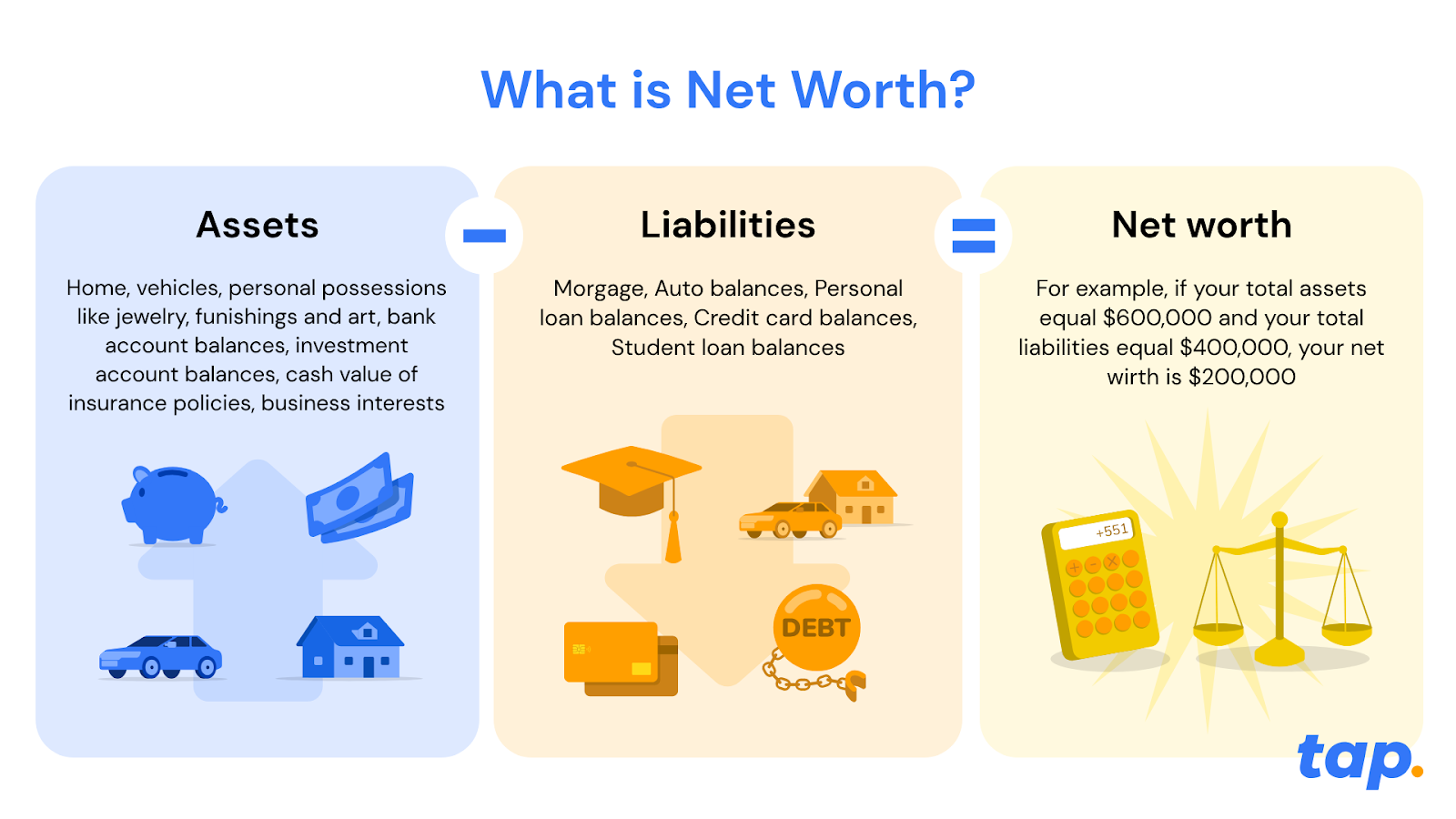
Why net worth beats income every time
You might earn $100,000 a year, but if you owe $150,000 in debt with only $20,000 in assets, your net worth is actually negative $130,000. Meanwhile, someone earning $50,000 with $200,000 in assets and $50,000 in debt has a net worth of $150,000. Who's really ahead?
The net worth formula
Assets (the good stuff you own)
- Real Estate: Your home, investment properties, land
- Investments: Stocks, bonds, mutual funds, crypto
- Retirement accounts: pension funds
- Cash & savings: Bank accounts, CDs, money market accounts
- Valuable possessions: Cars, jewellery, art, collectables
- Business interests: Ownership stakes, equipment
Liabilities (what's draining your wealth)
- Mortgages: Home loans, investment property loans
- Student loans: Education debt
- Credit cards: Outstanding balances
- Auto loans: Car payments
- Personal loans: Any other borrowed money
- Outstanding bills: Medical debt, taxes owed
How to calculate your net worth (3 simple steps)
Step 1: List your assets
Add up everything valuable you own. Be honest but don't undervalue quality items.
Step 2: Total your liabilities
List every debt, loan, and outstanding balance. Yes, even that store credit card.
Step 3: Do the maths
Assets - liabilities = your net worth
Real-world examples: Meet Sarah and Mark
Sarah's success story
Assets:
- Home: $400,000
- Savings: $50,000
- Investment Portfolio: $150,000
- 401(k): $200,000
- Vehicle: $20,000
- Total Assets: $820,000
Liabilities:
- Mortgage: $200,000
- Student Loan: $30,000
- Total Liabilities: $230,000
Sarah's net worth: $590,000
Sarah's doing great! Her assets significantly outweigh her debts.
Mark's comeback journey
Assets:
- Car: $10,000
- Personal Items: $5,000
- Total Assets: $15,000
Liabilities:
- Student Loans: $50,000
- Credit Cards: $8,000
- Medical Bills: $3,000
- Total Liabilities: $61,000
Mark's net worth: -$46,000
Mark has negative net worth, but this is his starting point, not his destiny.
6 reasons why it’s beneficial to grow your net worth
Financial security
Increasing your net worth provides a foundation of financial security. As your net worth grows, you have a greater buffer against unexpected expenses, job loss, or economic downturns. It offers a safety net to navigate through challenging times and helps you maintain stability in your financial life.
Achieving financial goals
A higher net worth enables you to achieve your financial goals and aspirations. Whether it's buying a home, starting a business, funding education, or retiring comfortably, a growing net worth provides the necessary resources and financial freedom to pursue your dreams.
Building wealth
Net worth is a measure of your wealth accumulation over time. By actively growing your net worth, you increase your overall wealth and improve your financial position. It allows you to build a stronger foundation for yourself and potentially leave a legacy for future generations.
Better financial opportunities
A higher net worth opens doors to better financial opportunities. It improves your borrowing capacity, allowing you to secure favourable loan terms and interest rates when needed. Additionally, a strong net worth can attract investment opportunities and partnerships that can further boost your wealth.
Flexibility and choices
Increasing your net worth provides you with more flexibility and choices in life. It affords you the freedom to make decisions based on what aligns with your long-term goals and values, rather than being constrained by financial limitations. A growing net worth expands your options and empowers you to take calculated risks or make life-changing decisions with confidence.
Peace of mind
Knowing that your net worth is growing can bring peace of mind. It reduces financial stress and anxiety, allowing you to focus on other aspects of your life. A positive net worth provides a sense of control over your financial well-being and offers peace of mind that you are on the right track towards a secure financial future.
Tips for increasing your net worth
Boost your income
- Level up your career: Ask for raises, pursue promotions, learn high-value skills
- Create side hustles: Freelancing, online businesses, passive income streams
- Invest in yourself: Education and skills that increase your earning power
Supercharge your assets
- Diversify smartly: Don't put all eggs in one basket
- Think long-term: Focus on assets that appreciate over time
- Get professional help: Financial advisors can spot opportunities you might miss
- Review regularly: Markets change - your strategy should too
Crush your debt
- Target high-interest debt first: Credit cards are wealth killers
- Consider consolidation: Lower interest rates = more money for you
- Create a payoff plan: Set deadlines and stick to them
- Avoid new debt: Unless it's for appreciating assets
Master the long game
- Emergency fund: 3-6 months of expenses (minimum!)
- Retirement planning: Start early, contribute consistently
- Professional guidance: Sometimes paying for advice saves you thousands
- Track progress: What gets measured gets improved
The bottom line: your financial transformation starts now
Your net worth isn't just a number; it's your financial GPS, showing exactly where you stand and where you're headed. Whether you're starting with negative net worth like Mark or building on a solid foundation like Sarah, the principles remain the same.
Remember: Every financial giant started with a single step. Your current net worth is just your starting line, not your finish line.
Start tracking your net worth today, and watch as this simple practice transforms not just your bank account, but your entire relationship with money. Your future self will thank you!
Ready to take control of your financial destiny? Calculate your net worth this week and set your first wealth-building goal. The journey to financial freedom starts with knowing where you stand.

For a fleeting moment, it looked like altcoin season was finally here. Google searches for “altcoins” skyrocketed to record highs, 𝕏 was buzzing, and retail excitement seemed to return in full force. But within a week, that hype fizzled out almost as quickly as it appeared, leaving traders wondering if the long-awaited alt season was just a mirage.
A Spike That Vanished Overnight
Search interest for “altcoin” on Google Trends hit its highest score ever in early August, only to fall back to baseline levels within days. Globally, the same pattern played out, with scores dropping from 100 to just 16 in a week, mimicking a “pump and dump” pattern that you would expect from a memecoin.
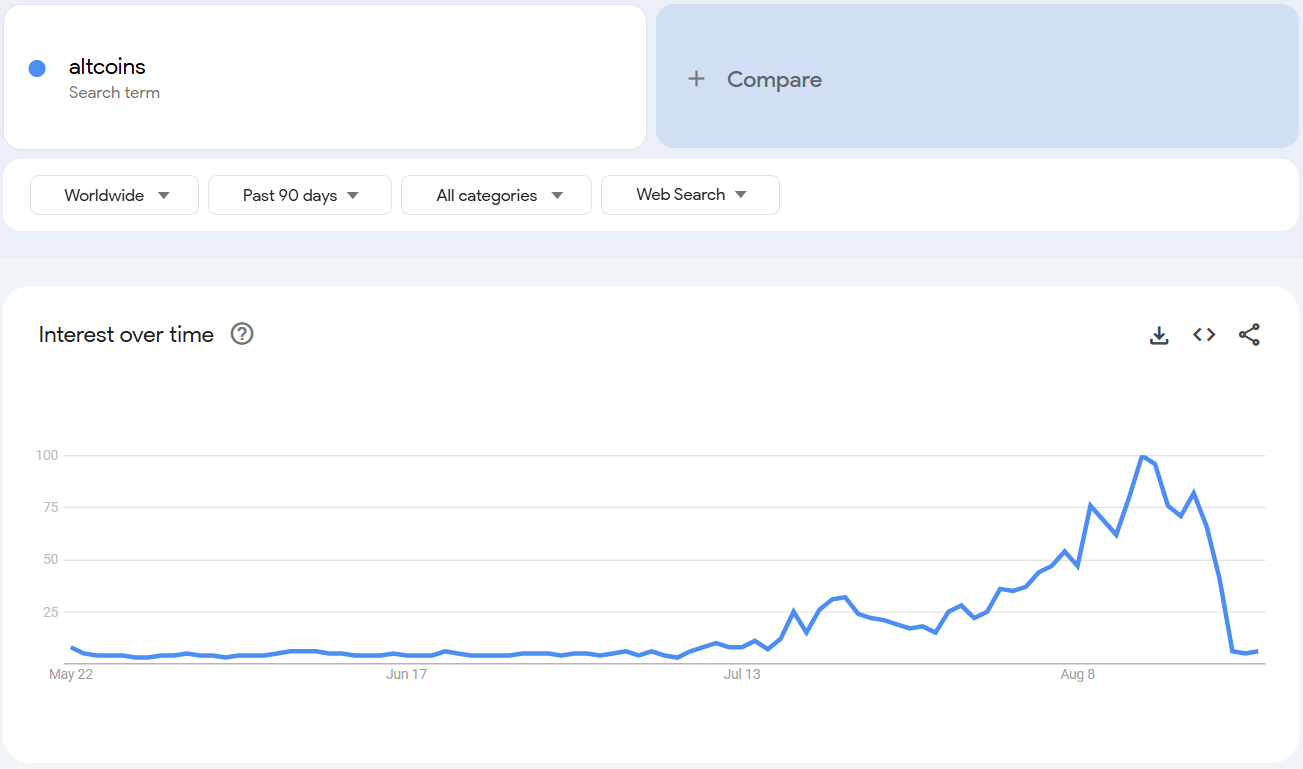
Market cap data told the same story. The total value of altcoins (excluding Bitcoin and Ethereum) briefly climbed by $100 billion before giving it all back, leaving investors wondering whether the hype had any real weight behind it.
Naturally, some saw the collapse as proof that the altcoin season had ended before it really began. Others, however, like analyst Cyclop, argue the spike shows something deeper: that “altcoin” has become the mainstream term retail uses today, replacing “crypto” in 2021. In his view, this isn’t the peak. Rather, it’s just the beginning of broader interest.
Why Google Trends Doesn’t Tell the Whole Story
Relying on Google searches to measure retail demand may no longer work the way it used to. With AI tools increasingly replacing traditional search, and with concepts like “altcoins” now part of everyday investor vocabulary, Trends data might not be capturing where and how money is really flowing.
Instead, analysts point to on-chain and trading activity as better indicators of where momentum is building. And in August, that momentum was fragmented.
A Season of Winners and Losers
Data from Artemis showed only a few categories outperforming last month: Ethereum, exchange tokens, and oracles.
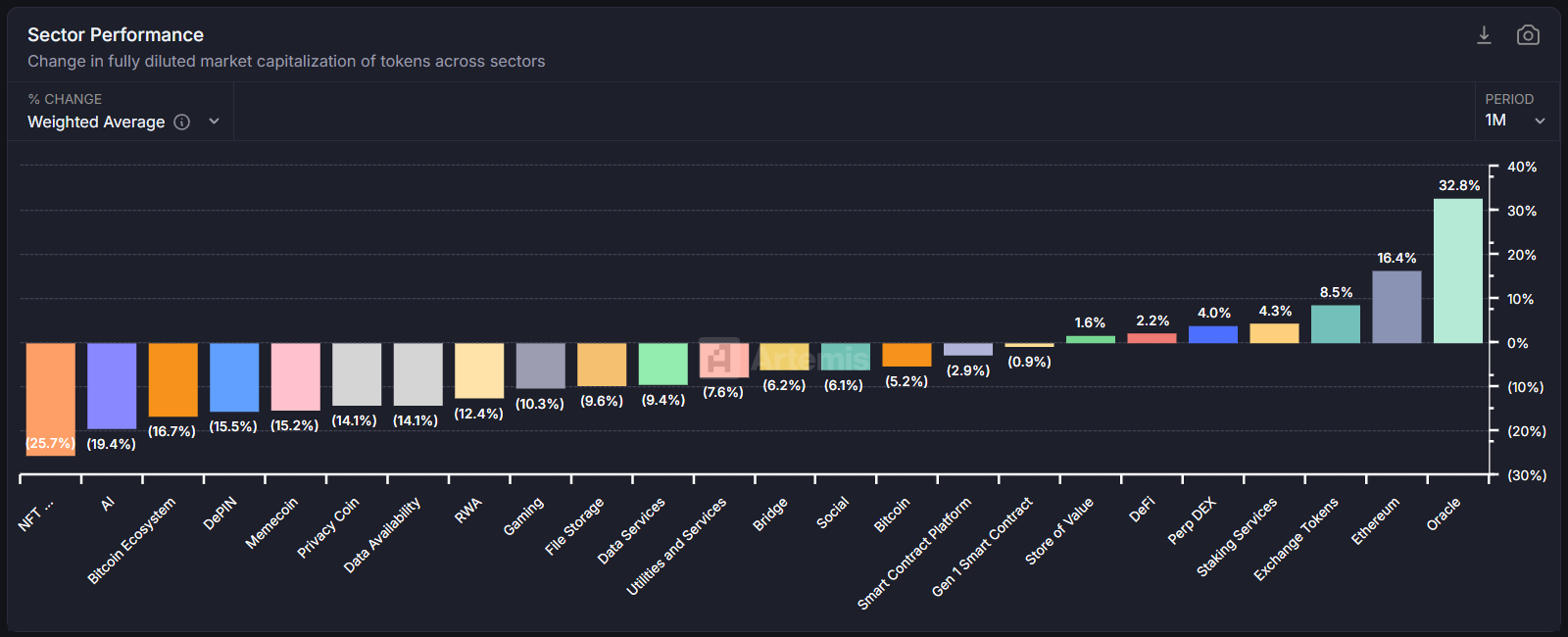
Beyond these bright spots, however, most altcoins struggled. The result? A patchwork “mini season” rather than the explosive, across-the-board surge that retail and social media had been hoping for.
Polygon’s co-founder Sandeep put it bluntly: "Retail is searching, but institutions aren't buying the narratives yet. Old altcoin seasons were driven by speculation and promises and narratives and marketing. Institutional money is smarter money. It cares about real utility and cash flows. The next "alt season" won't look like 2017 or 2021. It’ll be fewer tokens with actual usage, not just tokens with better marketing." Sandeep said.
The Road Ahead
That doesn’t mean altcoin season is dead, it probably just means it’s evolving. Coinbase has suggested that the next true wave could arrive as early as September, but that it likely won’t be a full-scale altcoin season.
Bottom line? The altcoin season isn’t gone; it’s just different. It’s maturing. And the next leg up may not belong to every token in the market, but only to the select few proving they can deliver value beyond mere speculation.
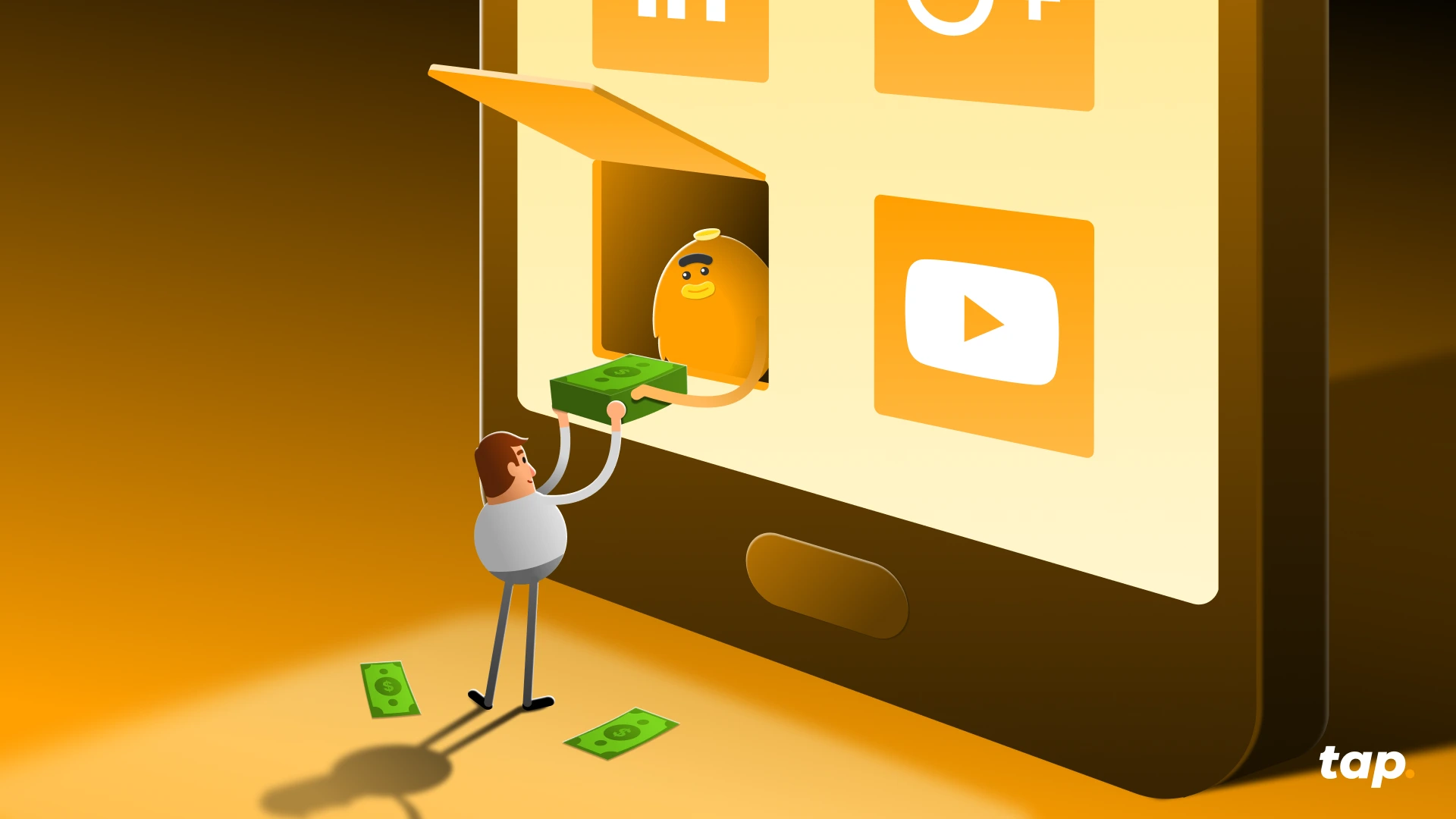
The internet has made earning money easier than ever - whether you want a side hustle for some extra cash or a full online business, the opportunities keep growing fast. From quick gigs to long-term passive income streams, there’s something for everyone.
But don’t expect to get rich overnight (and if someone promises you that, it’s more than likely a scam). With focus, patience, and smart moves, you can build real, sustainable income online.
This guide breaks down proven ways people are making money from home, some with zero upfront costs, others aimed at long-term growth. The trick? Find what fits your skills, time, and goals.
Let’s dive in!
1. Best ways to make money online quickly (low skill, high interest)
If you're new to making money online (see our beginners’ guide here) or need cash fast, these low-barrier options can help you start building income without any special skills. They won’t replace your 9-5, but they’re great for extra cash or to start building your online income game.
Paid online surveys
Surveys remain one of the easiest ways to start earning online. Companies pay for your honest opinion. No skills needed, just some spare time.
- Top platforms: Swagbucks, Branded Surveys, YouGov, Prolific
- Earnings: Typically £0.50-£3 per survey, 10-20 minutes each
- Tip: You’ll need to hit a payout threshold (usually £10-20) before withdrawing
Get paid to click, watch, or search
Earn small amounts doing simple online tasks like watching videos or using a search engine. It won’t replace a full income, but it adds up if you’re consistent.
- Try: Qmee, InboxPounds, Swagbucks
- Earnings: Pennies per task, but easy to do anytime
Micro-tasks
These quick gigs need human input, like data entry or web research.
- Platforms: Clickworker, Amazon Mechanical Turk, Lionbridge
- Pay: £2–£10 per hour, flexible hours
Test websites and apps
Give feedback on the usability and functionality of websites or apps.
- Sites: UserTesting, Userlytics, TryMyUI
- Pay: £8-£12 per 20-minute test
- Requirements: Good communication skills and reliable internet
Competitions and prize draws (comping)
Not guaranteed income, but some people win prizes worth thousands annually by entering competitions.
- Follow brands on social media for exclusive contests
- Use aggregator sites like LoquaxTM and MSE's Competition Corner
2. Medium-effort methods with reliable returns
These options require more skill or time investment but offer better earning potential and more engaging work.
Freelance writing and editing
Content demand is booming. If you can write clearly, this is a solid way to earn.
- Get started: Upwork, Intch, Freelancer
- Rates: Beginners £10-20/article; experienced £30-100+/hour
- Tip: Build a niche and portfolio gradually
Sell stock photos or videos
Monetise your photography/videography skills on platforms like Shutterstock or Adobe Stock.
Become a Virtual Assistant (VA)
Support businesses with admin tasks, social media, customer service, and more.
- Pay: £8-25/hour
- Build: Long-term client relationships for stable income
Sell handmade products
Use Etsy, Folksy, or Amazon Handmade to turn crafts into cash.
Sell digital products
High margins, no inventory. Popular items include Notion templates, Canva designs, ChatGPT prompts, and planners.
- Platforms: Gumroad, Etsy, Creative Market
3. Scalable and passive income streams
These take real effort up front, but once they’re set up, they can bring in steady income with little to no maintenance.
Dropshipping tips
Sell products online without inventory, using Shopify or WooCommerce.
- Profit margins: 3-7% after ads
- Requires skills in marketing and customer service
Print-on-demand
Design items like t-shirts or mugs are printed only when ordered.
- Platforms: Printful, Printify, Merch by Amazon, Redbubble
Start a blog or niche website
Earn through ads, affiliate links, sponsored content, and digital products.
- Takes roughly 6-18 months to grow, but can generate substantial passive income
Create and sell online courses
Share your expertise on platforms like Udemy, Teachable, Skillshare, or Coursera.
Write and publish ebooks
Self-publish on Kindle Direct Publishing or Smashwords. Good editing and marketing matter.
Launch a YouTube channel
Earn through ads, memberships, super chats, sponsorships, and affiliate marketing.
Side hustles that use your environment or possessions
Why not monetise what you already own?
- Rent property through Airbnb or Booking.com for significant income.
- Rent belongings like cars (Turo), equipment (Fat Llama), or parking spaces (JustPark).
- Sell unused items on Facebook Marketplace, eBay, or Vinted - many earn hundreds decluttering.
- Use cashback apps like Shoppix and TopCashback (or from your Tap card - up to 8% people) for purchases you're already making.
These options work especially well in urban areas and thankfully require minimal upfront investment.
What to watch out for
The internet is full of legitimate opportunities, but scams are unfortunately common. Protecting yourself is crucial.
Avoid scams, watch for:
- Promises of guaranteed big money with little effort
- Upfront payment requests for “training” or “kits”
- Pyramid or multi-level marketing schemes
Know your tax obligations. In the UK, you must report online income over £1,000 to HMRC. Keep good records and consider professional advice.
Understand platform rules. Check minimum payouts, fees, payment methods, and account policies before signing up. Always read the ts and cs.
Tips for success when earning online
Unlock your online earning power with these 5 no-fluff strategies:
- Use a separate email for online earning to stay organised and secure
- Track your earnings and time with a spreadsheet for insights and taxes
- Focus on higher-paying platforms and build skills accordingly
- Start small, then scale what works best for you
- Learn digital skills (SEO, copywriting, design, social media) via free online tutorials
Final thoughts
Making money online gives you freedom, but it also takes effort and patience. There’s no magic formula - some people thrive blogging, others with surveys or micro-tasks. Start small, learn, and expand gradually.
And lastly, watch out for scams, keep good records, and keep adding value. If you’ve made it this far, we believe you’re ready to take control of your online income journey!

When it comes to trading or investing, understanding how to read charts is essential. While some might choose to rely on intuition, it's important to have a strategy based on probabilities and risk management. That's where candlestick charts come in. In this article, we'll explore what candlestick charts are and how to interpret them.
What is a candlestick chart?
Candlestick charts, dating back to 17th-century Japan with their creation credited to a Japanese rice trader named Homma, are a crucial tool in financial analysis. They differ from traditional line and bar charts by offering a richer visual representation of price movements, as they are composed of structures that resemble a candle and represent different periods, ranging from seconds to years.
Candlesticks consist of a "body" representing the price range between opening and closing, with "wicks" or "shadows" extending above and below, illustrating high and low prices. Their unique design allows traders to quickly grasp market sentiment and potential reversals, making them indispensable in technical analysis.
Whether identifying bullish or bearish patterns, understanding candlestick chart basics is fundamental for anyone delving into the world of investment and trading.
Understanding how candlestick charts work
To create a candlestick, four price points are needed: open, high, low, and close. The open is the first recorded trading price, while the high and low represent the asset's highest and lowest prices during the timeframe. The close refers to the last recorded trading price.
These four points determine the shape of the candlestick, with the distance between the open and close called the body, and the distance between the body and the high/low referred to as the wick or shadow. The overall range of the candlestick is the distance between the high and low.

How to use candlestick charts
Popular with stock market traders, candlestick charts are often considered easier to read than traditional bar or line charts. They provide a simple representation of price action at a glance, as each candlestick represents the battle between buyers (bulls) and sellers (bears) during a specific time period. A longer body indicates stronger buying or selling pressure, while if the wicks are short, it means the high or low of the period was near the closing price.
The colour of the candlestick can vary, but generally, green means the asset closed higher than it opened, while red signifies a lower closing price. Some traders prefer black and white representation, where up movements are hollow candles and down movements are black candles.
Examples of single candlestick charts
Doji: A Doji has a small body with upper and lower wicks of roughly equal length, resembling a cross or plus sign. It signifies market indecision and potential reversals.

Hammer: The Hammer exhibits a small body at the top with a long lower wick, resembling a hammer. This candlestick advocates for a potential bullish reversal after a downtrend.

Shooting Star: The Shooting Star has a small body at the bottom with a long upper wick, resembling a falling star. It hints at a potential bearish reversal after an uptrend.

Spinning Top: A Spinning Top has a small body and short upper and lower wicks. It denotes market indecision, with neither bulls or bears in control.

Marubozu: A Marubozu features a long body with no wicks, indicating strong buying or selling pressure. A bullish Marubozu has a long green body, while a bearish one has a long red body.

These single candlestick patterns offer traders valuable information for decision-making in various market conditions.
Bullish and bearish candlestick charts
Bullish and bearish candlestick patterns are critical indicators in financial analysis, offering insights into market sentiment. Bullish patterns signal optimism, suggesting potential price increases. Examples include the Hammer, signalling a possible price reversal upward, and the Three White Soldiers, indicating strong buying momentum.
On the other hand, bearish patterns imply pessimism and potential price declines. The Shooting Star, for instance, hints at a reversal downward, while the Three Black Crows signify a bearish trend.
These candlestick patterns provide traders with visual cues regarding market sentiment, helping them make informed decisions. Recognizing these patterns empowers investors to gauge the market direction and make strategic moves in response to prevailing sentiment.
Candlestick charting strategies
Candlestick charting strategies are powerful tools for traders, providing insights into market sentiment and potential price movements. These strategies encompass various approaches to maximise trading success:
1. Trend reversal strategies
These strategies focus on identifying shifts in market direction using candlestick patterns. Traders look for reversal patterns like the Hammer or Shooting Star to pinpoint potential trend changes. These patterns offer valuable entry and exit points for both bullish and bearish trends, enhancing the trader's ability to capitalise on market reversals.
2. Continuation strategies
Continuation strategies involve using candlestick patterns to trade in the direction of the existing trend. Traders seek patterns that confirm the ongoing trend, such as the Bullish Engulfing pattern during an uptrend or Bearish Engulfing during a downtrend. Effective use of these patterns provides confirmation signals and risk management techniques to stay aligned with the trend's momentum.
3. Combination strategies with other technical indicators
To increase trading accuracy, traders often combine candlestick patterns with other technical indicators like Relative Strength Index (RSI) or Moving Average Convergence Divergence (MACD). This approach offers a comprehensive view of market conditions, enhancing decision-making and reducing false signals. Learning to integrate candlestick patterns with these indicators is crucial for traders looking to refine their strategies.
Incorporating these candlestick charting strategies empowers traders to make informed decisions and navigate the complex world of financial markets with greater precision and confidence.
What candlestick charts can’t illustrate
Although candlesticks provide a good overview of price action, they don't provide all the details for a comprehensive analysis. For example, they don't show the details of what happened between the open and close, only the distance between these two points. Additionally, candlestick charts can contain a lot of noise, especially when analysing lower timeframes.
What are Heikin-Ashi candlesticks?
Apart from traditional candlestick charts, there are other methods to calculate and interpret candlesticks. One such method is the Heikin-Ashi technique, which stands for "average bar" in Japanese. Heikin-Ashi candles rely on a modified formula that uses average price data to smooth out price action and filter market noise. This technique makes it easier to spot trends, patterns, and possible reversals in the market.
Traders often use Heikin-Ashi candles in combination with traditional candlesticks to avoid false signals and increase the chances of identifying market trends. Green Heikin-Ashi candles with no lower wicks indicate a strong uptrend, while red candles with no upper wicks suggest a strong downtrend.
However, it's important to note that Heikin-Ashi candlesticks have their limitations. Since they use averaged price data, patterns may take longer to develop, and they may not show price gaps or obscure other price information.
In conclusion
Candlestick charts are a fundamental tool for traders and investors. They provide a visual representation of price action and allow for analysis across different timeframes. By studying candlestick charts and patterns, combined with an analytical mindset and practice, traders can gain an edge in the market. However, it's also important to consider other methods, such as fundamental
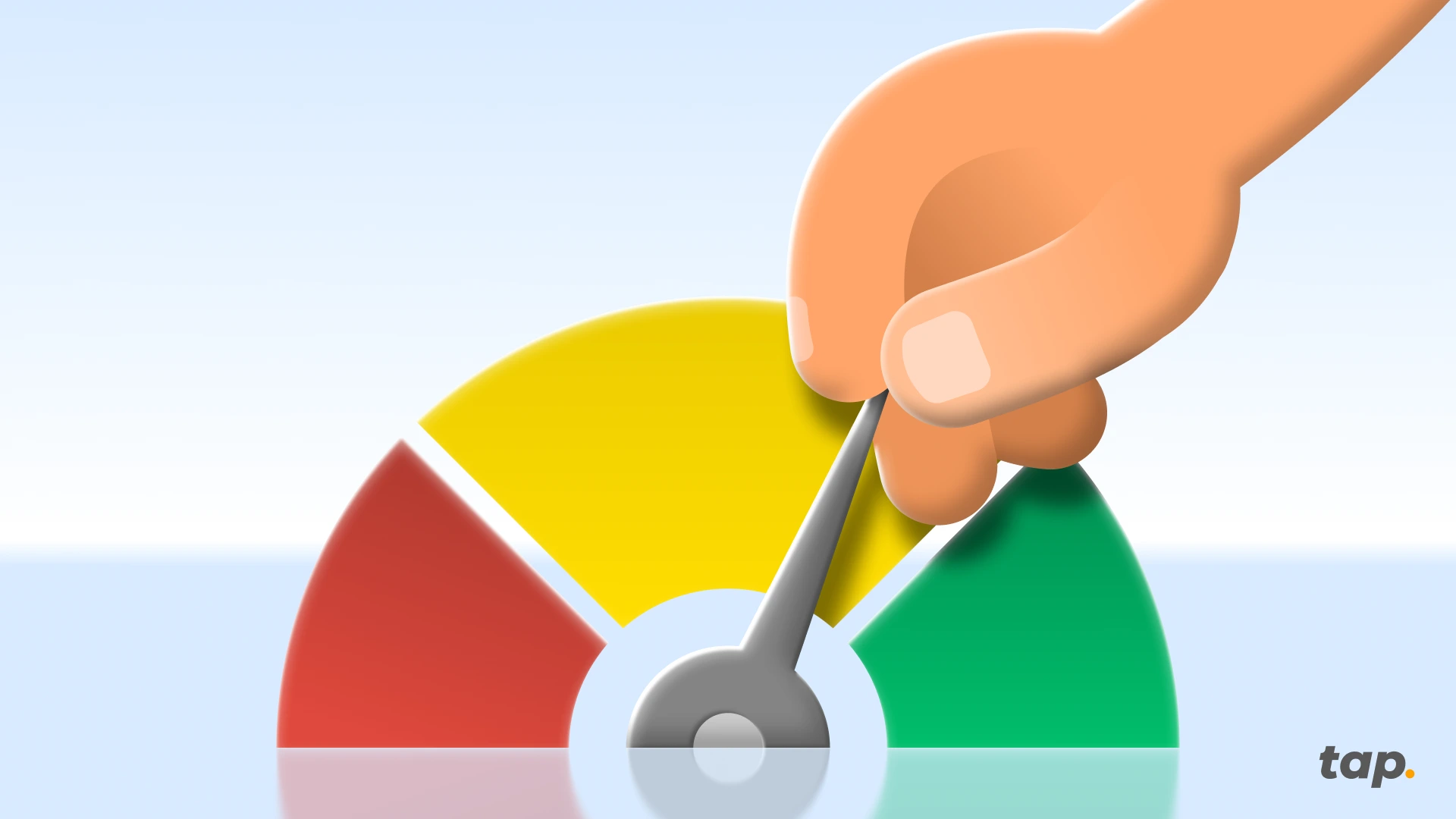
n the world of finance and technology, benchmarks are a vital tool for measuring performance and quality. A benchmark is a standard or point of reference used to evaluate the performance or quality of something, such as investment returns or the efficiency of software and hardware systems. This article will explore what benchmarks are, why they are used, provide examples, and explain how to use benchmarks to make more informed investment decisions.
What is a Benchmark?
A benchmark is a standard of comparison used to evaluate the performance or quality of something. In finance, benchmarks are often used to compare the performance of investments to a specific market index. For example, the S&P 500 index is a commonly used benchmark for evaluating the performance of a portfolio of stocks.
Benchmarks are also used in the technology industry to evaluate the efficiency and performance of hardware and software systems. For example, a computer's processing speed may be benchmarked against industry standards to determine how well it performs compared to other computers on the market.
Why are Benchmarks Used?
Benchmarks are used for a variety of reasons. In finance, benchmarks are used to evaluate the performance of an investment or a portfolio of investments. By comparing the performance of an investment to a benchmark, investors can determine whether their investment strategy is successful or not.
In the technology industry, benchmarks are used to evaluate the efficiency and performance of hardware and software systems. By benchmarking a computer or a software system against industry standards, developers can determine how well their product performs compared to other products on the market.
Examples of Benchmarks
There are many different benchmarks used in finance. Here are a few examples:
- S&P 500 Index - This is a benchmark used to evaluate the performance of a portfolio of stocks in the United States. It is widely used by investors as a measure of the overall performance of the U.S. stock market.
- Dow Jones Industrial Average - This is another benchmark used to evaluate the performance of the U.S. stock market. It is based on the stock prices of 30 large U.S. companies.
How to Use Benchmarks
To use a benchmark, you first need to select the appropriate benchmark for your needs. For example, if you are evaluating the performance of a portfolio of stocks, you would select a stock market index such as the S&P 500 or the Dow Jones Industrial Average.
Once you have selected a benchmark, you can compare the performance of your investment or product to the benchmark. If your investment or product outperforms the benchmark, then it is considered successful. If it underperforms, then you may need to adjust your investment strategy or product development.
How Do Benchmarks Help You Make More Informed Investment Decisions?
Benchmarks help investors make more informed investment decisions by providing a standard of comparison for investment performance. By comparing the performance of an investment to a benchmark, investors can determine whether their investment strategy is successful or not.
For example, if an investor's portfolio of stocks outperforms the S&P 500 index, then the investor can be confident that their investment strategy is successful. However, if the portfolio underperforms the S&P 500, then the investor may need to reevaluate their investment strategy.
Benchmarks also help investors identify trends in the market. By tracking the performance of a benchmark over time, investors can identify trends in the market and adjust their investment strategy accordingly.
Conclusion:
In conclusion, benchmarks are a fundamental tool used in finance and technology to measure performance and quality. They provide a standard of comparison that helps investors and developers evaluate the success of their investments and products.
Using benchmarks to evaluate investment performance and product efficiency can help you make more informed investment decisions. By comparing the performance of your investments or products to industry standards, you can determine whether your investment strategy or product development is successful or not.
Overall, benchmarks are an essential tool for evaluating performance and quality, and understanding how to use them is crucial for success in finance and technology.

This year has proven to be historical both in terms of substantial market fluctuations as well as regulatory development across a wide range of jurisdictions. As leadership around the world gears up to provide a much needed regulatory framework surrounding the blockchain and cryptocurrency industry, we explore the factors these bodies will need to consider in order to find the balance between implementing crypto regulation without stifling innovation.
Why regulation is necessary
There has long been a stigma in the industry against the regulation of cryptocurrencies, with many believing it will hinder the free-world currency. As Bitcoin and subsequent cryptocurrencies were created to oppose the constructs placed on people’s finances by governments and financial institutions, some feel that regulation will disarm the decentralized nature of its use.
This is however untrue. With regulation comes widespread education and, many believe, adoption. With more frameworks in place constituting what one can and cannot do with the digital assets, comes clearer concepts of what the currency can achieve, and more fingers in the pie, so to speak.
At this point, it would be foolish to assume that a wave of regulation is a remote possibility. Governments around the world are in the midst of creating their own regulation and enforcement memorandums, some being more public about it than others.
What factors crypto regulation policymakers need to consider
For many industry insiders, this move is a positive step forward, and a vital one if the industry is to become an integral part of daily life, as anticipated. According to Everett Rogers’ technology adoption lifecycle model, as more investors outside of the blockchain industry turn to digital currencies purely based on the regulation in place, the lifecycle of adoption steadily increases.
As the key goal here is to protect investors from financial losses, there is concern that any stifled, misguided policies will hinder the innovation and prosperity of cryptocurrencies. Hence, here are the following factors that deem most important when walking the tightrope trying to find a balance between the two goals.
- Market Participation
In order to properly understand and implement policies regarding the crypto market, prominent figures in the industry should be consulted. Typically, most governments don’t have a team of crypto-enthusiasts to converse with.
Market participants should be at the centre of their debates and should provide valuable insight as well as vast expertise into how digital payment systems function. Policymakers need to ensure that they are collaborating with appropriate expertise should they wish to get this right.
- Gradual Implementation
While it might seem tempting to build and implement a highly complex regulatory framework around an industry that is just over a decade old overnight, this process needs to be done slowly and intricately if it intends to succeed.
There is little need to rush to impose policies across the board without proper and thorough examination and reflection. Instead of barring the industry with sanctions that might make little sense, policymakers should consider taking a slow and steady approach to build regulation governing the industry, as the consequences of not doing so can be dire.
- Deserved Recognition
Giving credit where credit is due, cryptocurrencies are unique assets and cannot be treated with the same standards as stocks, commodities, etc. The digital currencies process distinctive characteristics that need to be respected and celebrated as opposed to sanctioned by people in power who do not understand their worth.
Therefore, outdated policies need to be rebuilt if they wish to be constructive.
As the first globally decentralized industry, the blockchain and cryptocurrency industry requires a slow and steady implementation of regulation, one that materializes organically as opposed to in a rushed, authoritarian manner. By opening a dialogue between policymakers and private-sector expertise, the process can be developed and debated at a pace that guarantees success.
Regulation Efforts To Date In The US
Considering that an estimated 46 million people in the United States hold cryptocurrency and that the DeFi (decentralized finance) industry has grown by over 6,000% this year alone, a number of regulatory bodies in the US have geared up to take action.
Various bodies have taken different ventures into the crypto regulation space, with the President’s Working Group on Financial Markets studying stablecoins, Congress introducing legislation that ensures “comprehensive” crypto regulation, and the SEC threatening and suing cryptocurrency companies at an alarming rate.
To date, the SEC has been in a complicated legal battle with RippleLabs, the company behind XRP, and scared Coinbase from launching a Lend feature with threats of legal action if they do so. Tom Emmer, a lawmaker interested in blockchain, has called out the SEC for their threatening manner, citing that:
“I disagree with [SEC Head Gary Gensler] strenuously when he suggests that almost all of these [crypto products] are securities. I think the vast majority of cryptocurrency offerings or related offerings are actually currencies or commodities. The SEC is not involved. If the SEC were to deem one of these coins a security, the value of that token would plummet. And those retail investors would be seriously hurt — that’s directly the opposite of his mission and his authority.”
Finally, the international pioneer in combating money laundering, the Financial Action Task Force, has issued a draft guidance report encouraging countries to regulate unhosted wallets in an attempt to hold those who profit from these accountable.
Regulation Efforts To Date In The UK
The United Kingdom has also set about to regulate cryptocurrency trading, however, in a less disruptive manner. The regulatory body, the Financial Conduct Authority (FCA), targeted trading platforms requiring them to present information required in order to verify and certify their company practices.
One of the largest crypto trading platforms failed to do so and subsequently lost the right to provide services to UK citizens. While trading of digital assets in the UK is not strictly prohibited, the platforms offering these services are required to be registered with the FCA and prove that they comply with anti-money laundering rules, particularly in the crypto derivatives market.
More recently, the deputy financial stability officer for the Bank of England, Jon Cunliffe, called for crypto regulation to be pursued as a matter of urgency, warning that crypto poses “a rapidly growing threat to the global economy.”
Cunliffe went on to compare the 2008 financial market crash to what could occur should the crypto markets take on a similar crash. He noted that the instigator in the crash, the $1.2 trillion subprime market, was but a tiny portion of the $250 trillion global financial system at the time, and a significantly smaller segment of the market than what the cryptocurrency market is today.
This is largely due to a report released by the IMF (International Monetary Fund), calling for governments to create a regulatory framework around the world. The report further warned that heightened adoption could weaken fiat currencies, destabilise capital flows, and promote tax evasion.
With Regulation Comes Growth
As this technical revolution continues to develop and grow, regulatory bodies around the world must work constructively to build and implement regulations that support the benefits that cryptocurrencies have to offer and allow society to evolve into a superior version of itself as a result.
There is little doubt that the cryptocurrency market is now on the top of the agenda for central bank leaders and finance ministers around the world. While cryptocurrencies weren’t designed to be contained by (government-constructed) laws, regulation is a necessary step forward in the worldwide adoption of digital assets. Regulation should be viewed as an accolade instead of a hindrance.
With more structural framework, comes an indubitable acceptance that cryptocurrencies have entered mainstream financial markets, proving that they are indisputably here to stay.
TAP'S NEWS AND UPDATES
What’s a Rich Text element?
What’s a Rich Text element?The rich text element allows you to create and format headings, paragraphs, blockquotes, images, and video all in one place instead of having to add and format them individually. Just double-click and easily create content.
The rich text element allows you to create and format headings, paragraphs, blockquotes, images, and video all in one place instead of having to add and format them individually. Just double-click and easily create content.Static and dynamic content editing
Static and dynamic content editingA rich text element can be used with static or dynamic content. For static content, just drop it into any page and begin editing. For dynamic content, add a rich text field to any collection and then connect a rich text element to that field in the settings panel. Voila!
A rich text element can be used with static or dynamic content. For static content, just drop it into any page and begin editing. For dynamic content, add a rich text field to any collection and then connect a rich text element to that field in the settings panel. Voila!How to customize formatting for each rich text
How to customize formatting for each rich textHeadings, paragraphs, blockquotes, figures, images, and figure captions can all be styled after a class is added to the rich text element using the "When inside of" nested selector system.
Headings, paragraphs, blockquotes, figures, images, and figure captions can all be styled after a class is added to the rich text element using the "When inside of" nested selector system.What’s a Rich Text element?
What’s a Rich Text element?The rich text element allows you to create and format headings, paragraphs, blockquotes, images, and video all in one place instead of having to add and format them individually. Just double-click and easily create content.
The rich text element allows you to create and format headings, paragraphs, blockquotes, images, and video all in one place instead of having to add and format them individually. Just double-click and easily create content.Static and dynamic content editing
Static and dynamic content editingA rich text element can be used with static or dynamic content. For static content, just drop it into any page and begin editing. For dynamic content, add a rich text field to any collection and then connect a rich text element to that field in the settings panel. Voila!
A rich text element can be used with static or dynamic content. For static content, just drop it into any page and begin editing. For dynamic content, add a rich text field to any collection and then connect a rich text element to that field in the settings panel. Voila!How to customize formatting for each rich text
How to customize formatting for each rich textHeadings, paragraphs, blockquotes, figures, images, and figure captions can all be styled after a class is added to the rich text element using the "When inside of" nested selector system.
Headings, paragraphs, blockquotes, figures, images, and figure captions can all be styled after a class is added to the rich text element using the "When inside of" nested selector system.What’s a Rich Text element?
What’s a Rich Text element?The rich text element allows you to create and format headings, paragraphs, blockquotes, images, and video all in one place instead of having to add and format them individually. Just double-click and easily create content.
The rich text element allows you to create and format headings, paragraphs, blockquotes, images, and video all in one place instead of having to add and format them individually. Just double-click and easily create content.Static and dynamic content editing
Static and dynamic content editingA rich text element can be used with static or dynamic content. For static content, just drop it into any page and begin editing. For dynamic content, add a rich text field to any collection and then connect a rich text element to that field in the settings panel. Voila!
A rich text element can be used with static or dynamic content. For static content, just drop it into any page and begin editing. For dynamic content, add a rich text field to any collection and then connect a rich text element to that field in the settings panel. Voila!How to customize formatting for each rich text
How to customize formatting for each rich textHeadings, paragraphs, blockquotes, figures, images, and figure captions can all be styled after a class is added to the rich text element using the "When inside of" nested selector system.
Headings, paragraphs, blockquotes, figures, images, and figure captions can all be styled after a class is added to the rich text element using the "When inside of" nested selector system.What’s a Rich Text element?
What’s a Rich Text element?The rich text element allows you to create and format headings, paragraphs, blockquotes, images, and video all in one place instead of having to add and format them individually. Just double-click and easily create content.
The rich text element allows you to create and format headings, paragraphs, blockquotes, images, and video all in one place instead of having to add and format them individually. Just double-click and easily create content.Static and dynamic content editing
Static and dynamic content editingA rich text element can be used with static or dynamic content. For static content, just drop it into any page and begin editing. For dynamic content, add a rich text field to any collection and then connect a rich text element to that field in the settings panel. Voila!
A rich text element can be used with static or dynamic content. For static content, just drop it into any page and begin editing. For dynamic content, add a rich text field to any collection and then connect a rich text element to that field in the settings panel. Voila!How to customize formatting for each rich text
How to customize formatting for each rich textHeadings, paragraphs, blockquotes, figures, images, and figure captions can all be styled after a class is added to the rich text element using the "When inside of" nested selector system.
Headings, paragraphs, blockquotes, figures, images, and figure captions can all be styled after a class is added to the rich text element using the "When inside of" nested selector system.Kickstart your financial journey
Ready to take the first step? Join forward-thinking traders and savvy money users. Unlock new possibilities and start your path to success today.
Get started



.webp)







.webp)